Tanteidan 10 Journal
Pre-convention
I started my Tanteidan adventure on the night between the 15 and 16 of August with a long, long flight from Ben-Gurion airpot near Tel-Aviv to Narita airport outside Tokyo, with a connecting flight in Bangkok. Unfortunately, all good things in life must end (and how can a 10 hour flight with two 3 year olds in the next seat be anything but good?). But alas, even this pleasure eventually came to an end, and on the morning of the 17’th of August I found myself facing a suspicous costums officer. After showing him the New Year’s card I got from the Gallery Origami House, with it’s invitation to the Tanteidan convention, everything went that much smoother. From there, I followed the excellent instuctions given by the generous Anne Lavin and had no problem navigating my way to the Weekly Mansion, my home for most of the following two weeks.
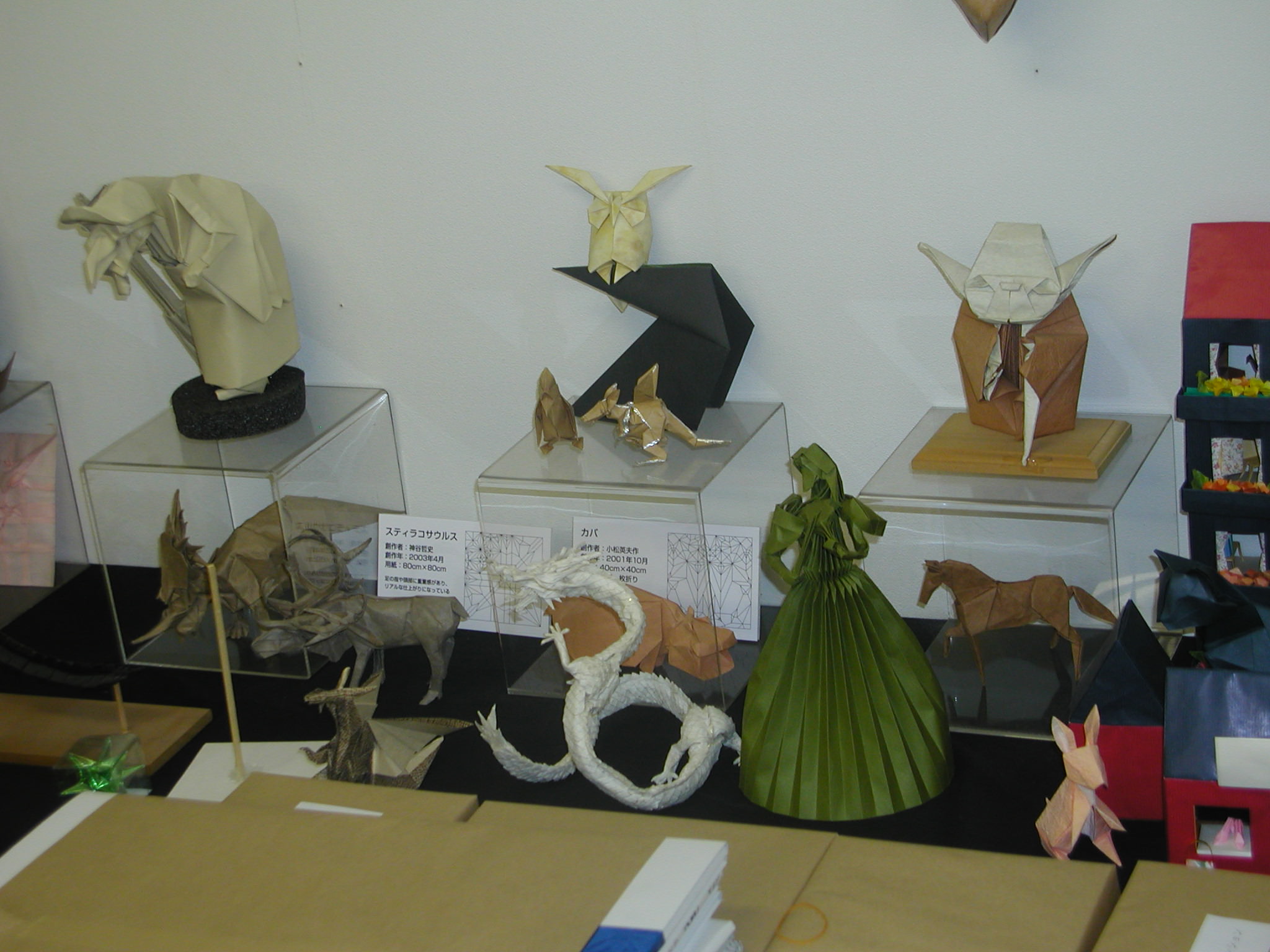
Upon reaching the reception, I discovered that neither of the staff members knew any English (though one of them did know French). The procedure would have involved quite a bit of finger pointing, had Deb Pun not chosen that moment to come down. With her help I quickly finished all the procedures and went up to check my room. I was curious what this “Weekly Mansion” was all about, knowing that there wasn’t anything exactly like it in “Western” standards. The room was quite, erm, compact, but I really liked it. In addition to the bed, it also had lots of usefull items, such as a refrigerator, hot plate, TV and even a kimono! After settling down I decided to postpone sleeping a bit, and made my way to the Gallery Origami House, just one subway stop away.
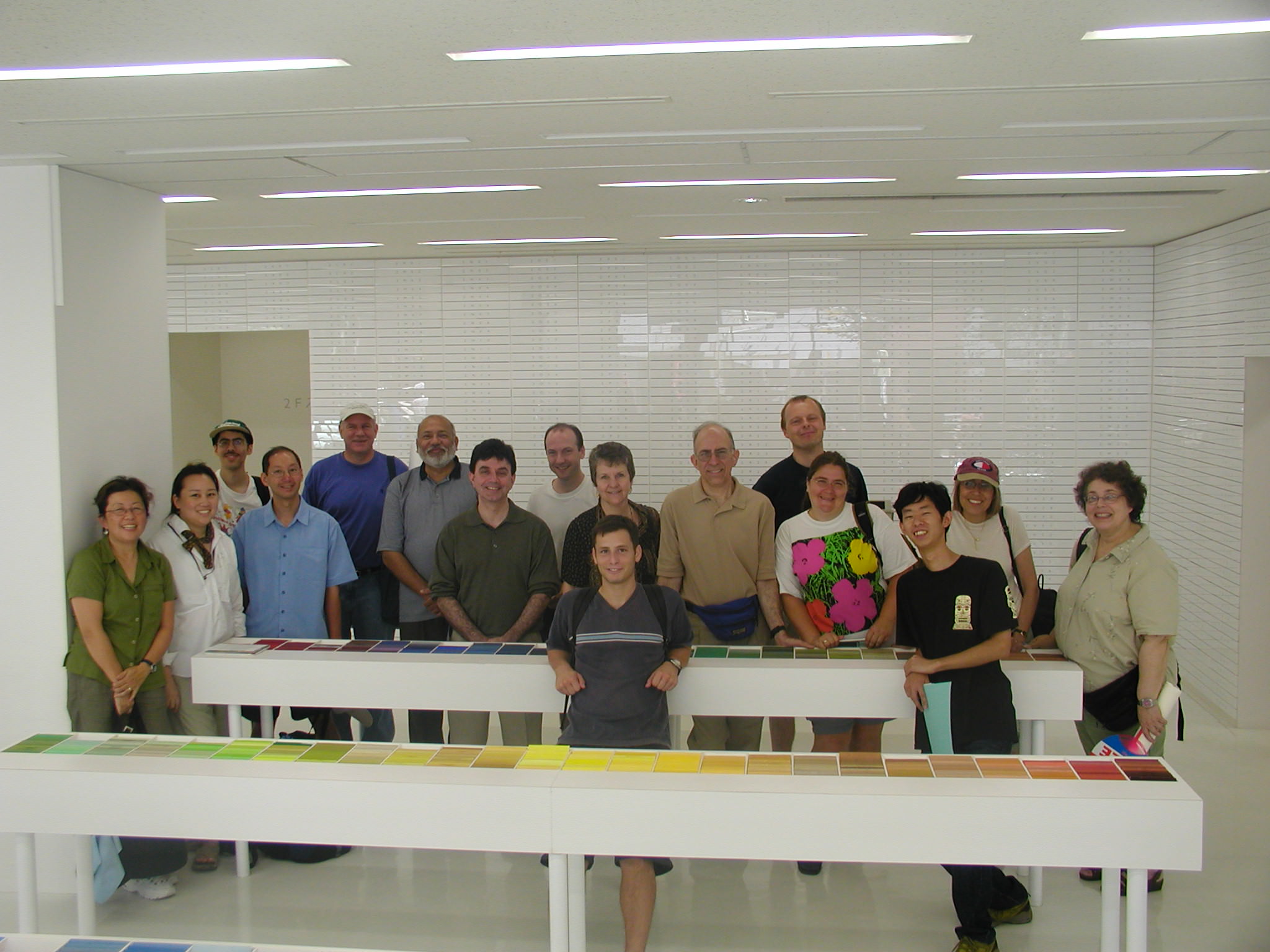
The Gallery Origami House is quite a lovely place. Even before entering it you can see it’s outer section, the gallery. The most famous origami models from around the world are put on display here, as well as some other interesting models that no one knows how they came to be there (such as an interesting Mickey Mouse). I was quite surprised with the size of some of the models I had seen on the internet or on the cover of the Tanteidan magazines. Most notabley, Satoshi Kamiya’s Wasp and Ryu-Zin were both much much smaller than I had thought them to be. After passing this small gallery you enter the area that acts as a shop. All the GOH publication are availabe for sale here (except “Origami Fantasty”, that is) as well as many papers, including a 35cm pack to Japanese foil which I immediatly bought and a 35cm of patterened paper equiped with unique T-Rex diagams by Satoshi Kamiya. After the shop you can enter the work area where a substantial origami library is located. And last, in a tiny alcove, where three Mac’s proudly reside, all of the high quality GOH publications are home-made. Truly, an inspiring place.
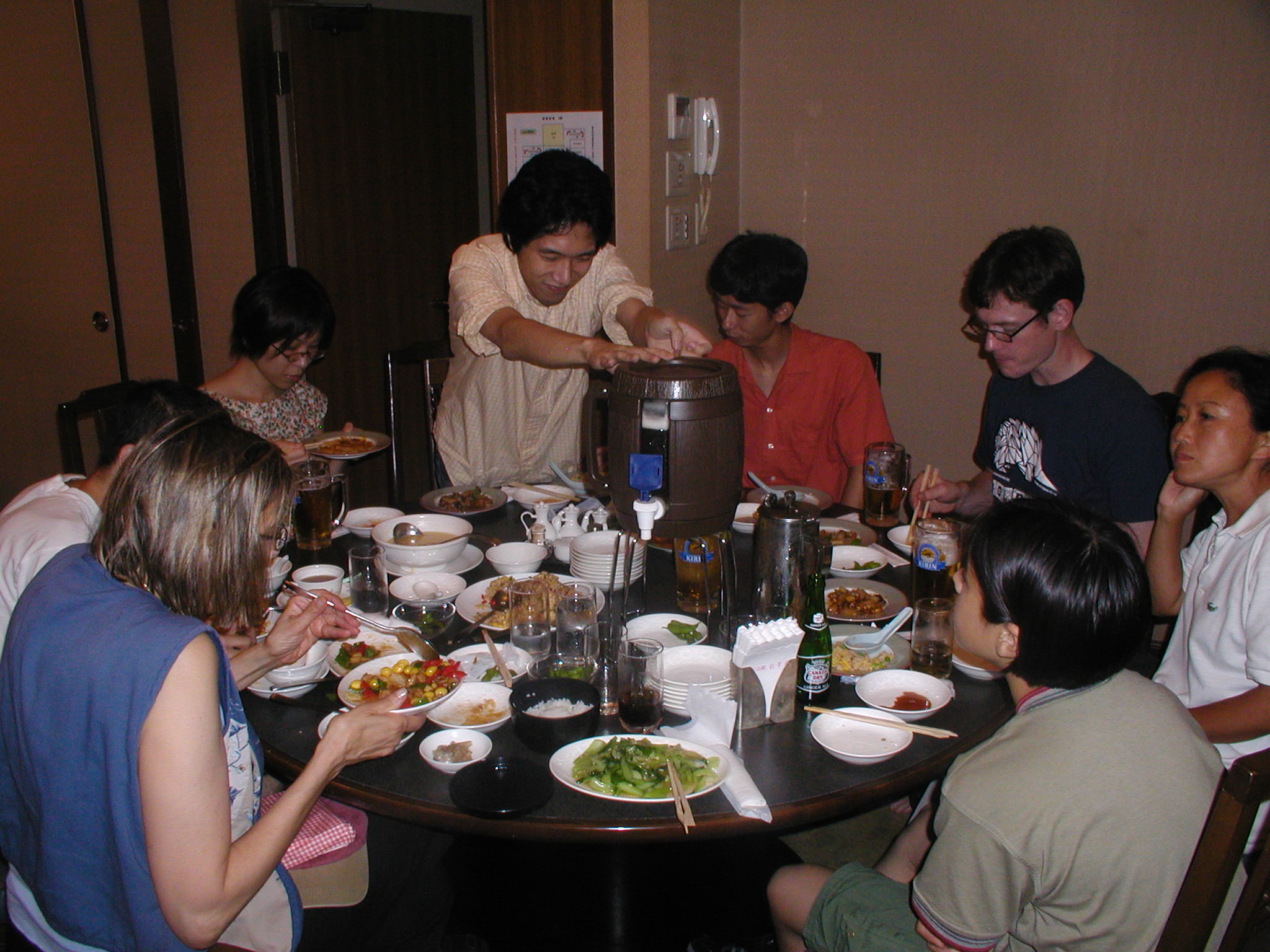
During the next three days, more and more gaijin (non Japanese) swarmed in. Every day we met at our home base, the GOH, and left to tour Tokyo. Under the guidence of the more experienced, we reached plenty of interesting places. We started with the Tokyo Hands mega store, which is a huge store filled with everything you can hope for, from origami paper and office supplies, through lamps and electricity to hiking equipment. After that we went to the Kinokuya book store. Much to our disappoitment, there was very little about origami there, as apposed to the U.S. branches. But I did manage to find a Japanese version of the fameous “Frog and Toad” children’s books, with which my younger brother and myself learned English years ago. In the hopes of someday learning Japanese, I purchased one of these.
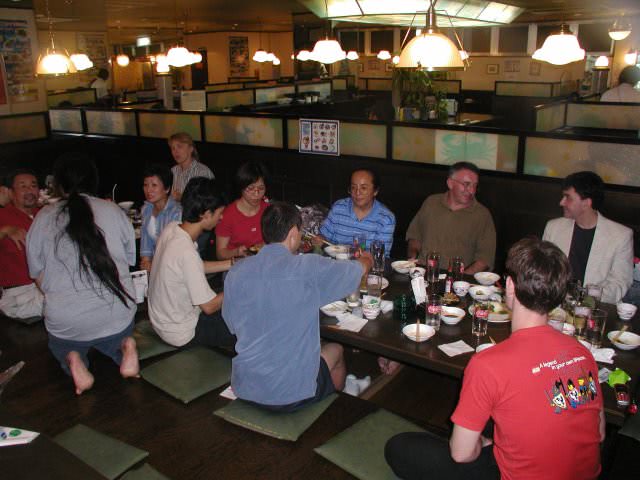
We continued these shopping trips over the next few days. We visited the beautiful Takeo paper store, in which rows of sample papers, of every color and texture, where lines on tables, and the white walls were actually hundreeds of drawers filled the larger sheets. After that, we visited the Ito-ya store, and it’s impresive section of hand-made papers. I refrained from buying anything, prefereing to save my money for the hand made factories I knew we’d visit after the convention.
During these days, we ate together in various restaurants. Being a strict vegeterian, I had my doubts, but with the kind help of Joseph Wu, Satoshi Kamiya and Anne Lavin I was able to pass these days without eating any corpses. And once these doubts were layed to rest, I was able to enjoy the food. Well, only after I “mastered” the secret of the chopsticks, that is. While I can now eat with them, I’m still quite a novice, as I can’t fold a crane with them.
Most of the restaurants are based around set meals, and they have plastic meals outside as menus. These plastic meals are so carefully done that at first I was sure they were real. Even the plasic beer looked real! The more traditional Japanese restaurants also have a lot of ceremony around them. At one resaurant I had a cold noodle meal, which needs to be eaten as so - You start pouring a bit of fish-broth from one container to another (I used soy sauch instead), then, from a third container you add a bit of spicing, most noteable the famous wasabi. Once this is done, you start taking the noodles and diping them in this mixture, and then, with a loud slurping sound, eat them. After finishing the noodles, the waiters bring you the hot water in which the noodles where made. You them add this to the broth in which you dipped the noodles, and drink it as if it were a soup.
Convention
On Friday we went to the Toyo University for the openning of the convetion. After spending some time looking at the display of the origami Yokai (Japanese goblins and monsters), I entered the large auditorium where the first day of the convention wes to be held. The convention was started with presenting the awards to the three winners of the Yokai contest. After that, origami master Akira Yoshizawa, entered on his wheelchair and his wife read his speech for him. This speech was later surmerised in English. From what I could understand, the speech was about Akira Yoshizawa’s attemprs to track soem of his earlier models, which he had thought lost, so that they can be preserved for future generations, so that they may know the history of origami. It also spoke about the beauty of origami - both in the representational forms and the geometric structures the lie behind them.
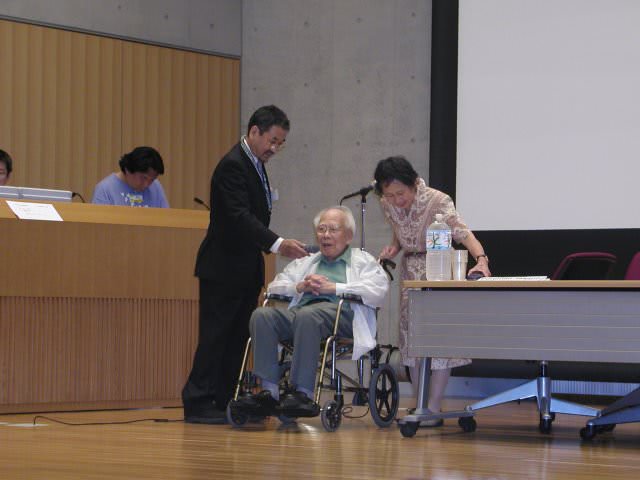
Next was a funny origami performance by Eric Joisel. He had a lot of his models and unfinished pleated designes thrown on the table. Despite the humor, a lot of interesting things were said. He compared some of his pleated designs to those made with cloth for more than a century. He talked a lot about his attempts to get away from flat models. Due to having to stop every few sentances to allow Hatori Koshiro to translate, he was sadly not able to talk about everything he wanted to.
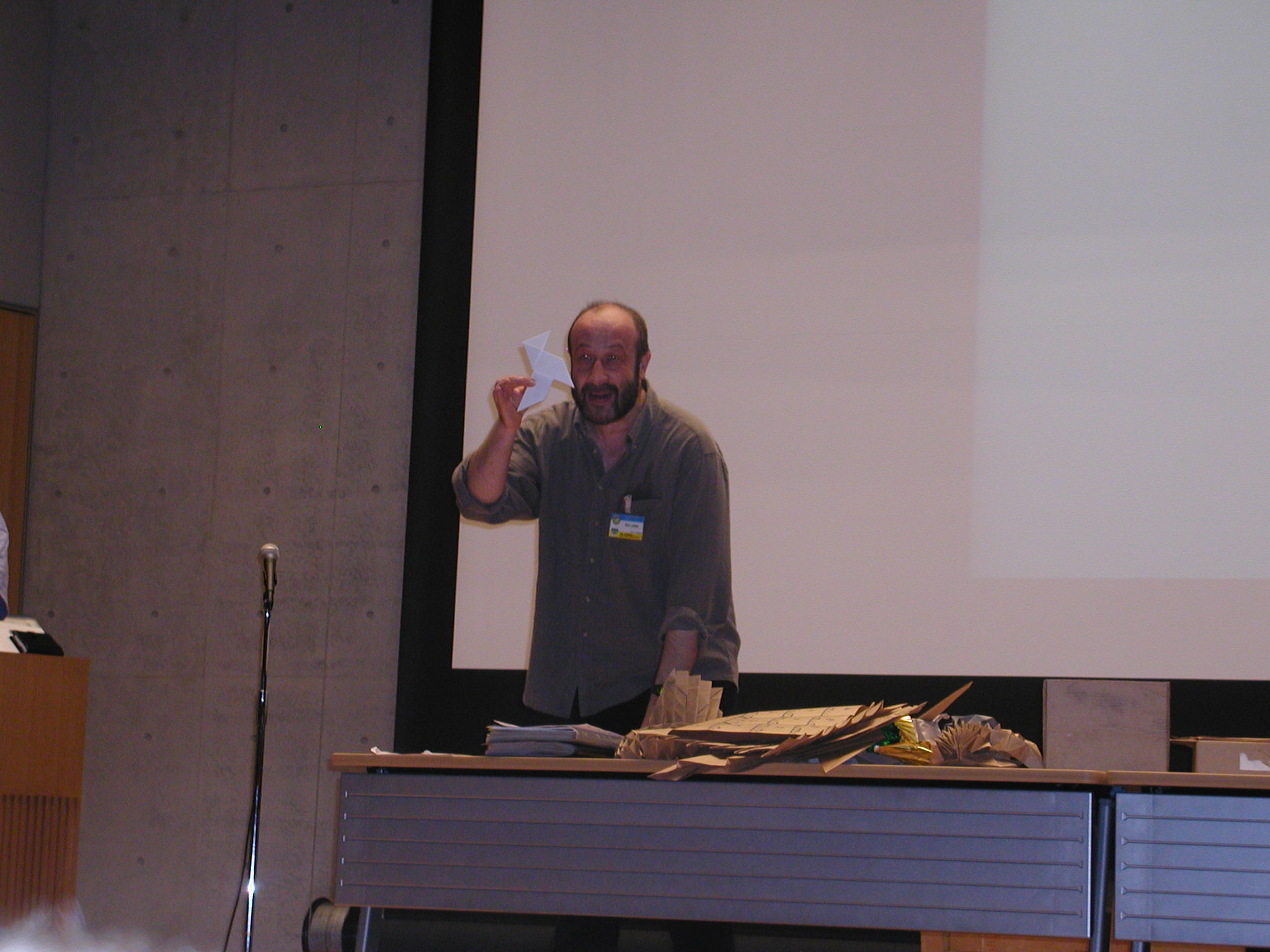
After Eric, Tom Hull gave an interesting lecture abouty teaching origami in higher eductation. He talked about how he gives his students mathematical problems using origami. He gave examples of the Fujimoto approximation and of finding the largest equilateral triangle in a square. After that he gave a long list of fields in mathematics that can be taught with origami.
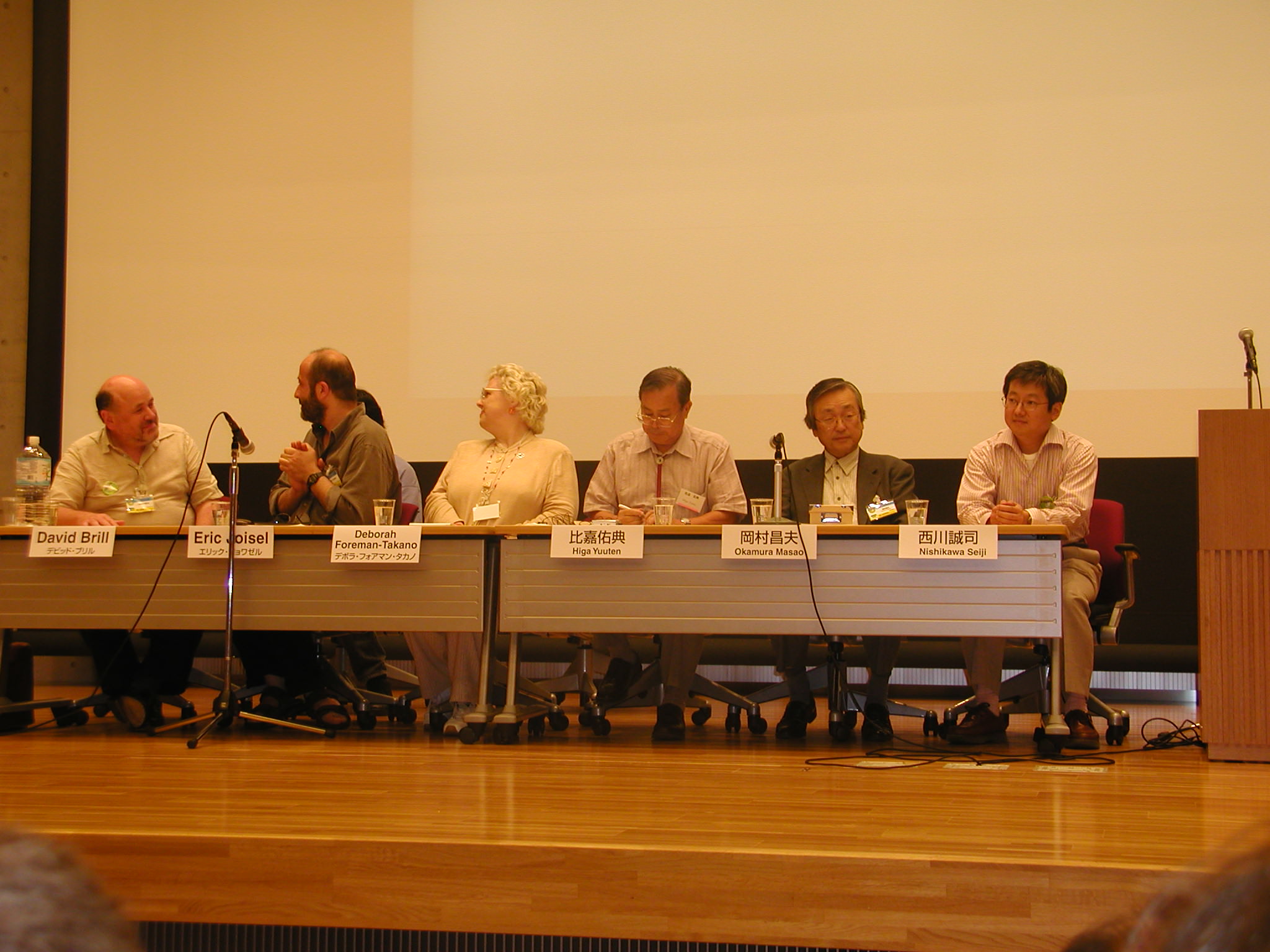
Third to talk was Hatori Koshiro, who talked about classic European origami. Although the lecture was only given in Japanese, we got papers with an English summery, so we could follow the slide shows. The lecture was very interesting, and showed evidence that origami probably developed independently in Europe. Besides pictures of various origami models as early as the 17’th century, Hatori also pointed out the differences in design - classic European origami is based around 45 degree angles (for example, the pajarita) and rarely imployed cuts, while classic Japanese origami is based around 22.5 degree angles (crane, frog, …) and uses cutting heavily.
The fourth lecture, by Miura Setsuo from Toyo University was about Yokai, Japanese mythological goblins. This lecture was only given in Japanese and we could not follow. However, a funny story about a creature called “Kappa” was translated. A Kappa is a creature living near rivers. The source of their power is in the water that’s inside a bowl atop their heads. The way to defeat these monsters is to bow to them, and then they, like all good Japanese, will bow back, and all the water on their head will spill.
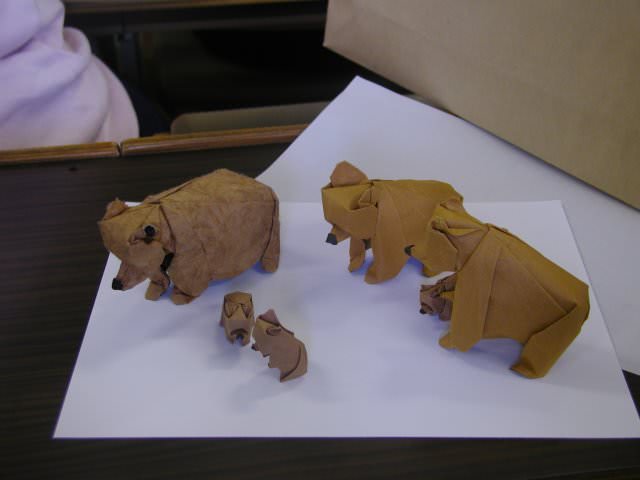
Last was a panel about Origami around the world, hosted by Maekawa Jun, and after that we evacuated the auditorium. Nothing more was planned for the day and everyone left to their homes.
The next day we arrived early to set up the model menu and register for the classes. Besides the models to be taught, the model menu room had the displays of various people, several items for auction, and registeration booths for various origami organizations from around the world. There were many interesting variations of the Maekawa Devil and the classic crane. After some consideration, and using the English translation of the schedual hand-written by the good Elsa Chen, I decided which classes to choose. For the first day I chose Giang Dinh’s Bear and Jun Maekawa’s Chicken and Chic (I wanted to take classes about different styles of origami, and each of the above teachers is a master in their field). I thought about taking Hojyo Takashi’s class on his latest Gabriel model, but as I had to teach a class in the middle, I wasn’t able to. I later learned that people who took that class spent the entire 3 hours just barely reaching the model’s base, which is quite a distance from the finished model.
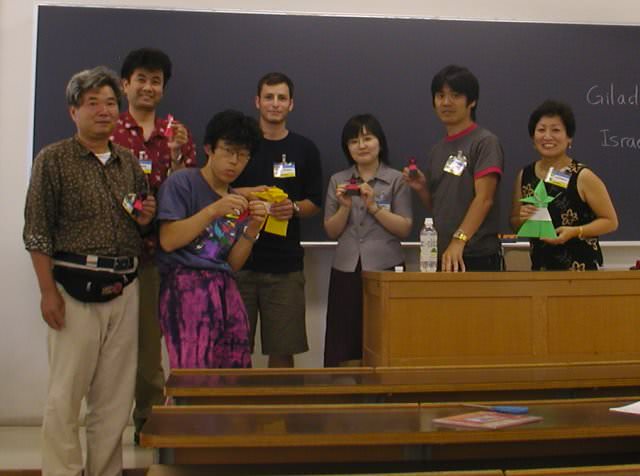
Before the classes started, the 3 Yoshino invited guests gave their openning words. Most interesting was Nathan Geller’s speech, explaining how he slowly learned to design models, starting from changing other people models all the way to designing a new model from scratch. He then explained a bit about the challanges in various designs, and gave his wild goat as an example - the difficulcy of using a box-pleated base to achieve a curved shape. He also noted a certain case in which he was looking for a picture of a beetle, and after searching the internet, he almost all of the pictures of this type of beetle turned out to be origami beetles, and not real ones!
Giang’s class was extremely interesting. The class room was completely crouded with people of all ages. Although this was his first time teaching, Giang did a wonderful job, with the ever present Hatori Koshiro translating. Giang’s bear is one of those models that’s very easy to fold and very difficult to fold well. During the class I managed something passable, but now at home it took me about 5 tries to get something that’s “okay”.
Once the class was over, I hurried to a different classroom to prepare for teaching my Hooded Warrior model. Jun Sakamoto joined me shortly to translate. I didn’t have any trouble teaching the class, and had some time left to explain different variations of the model.
I left the campus to get lunch at a 7-11 near by, after getting lost trying to find the cafeteria. I ate and then hurried to the last class of the day, the one given by Maekawa sensei. We were given crease patterns with a couple of step folds to help, but Jun Maekawa took us step by step the entire way. I though the models to be quite different. The last step involves making the body 3D, and the result is something that looks like a polyhedra, with legs, wings, and a head. It reminded me of computer 3D models built with polygons.
The next day I signed up for two long classes, the first was Satoshi Kamiya’s butterfly, and the second was a face by Eric Joisel, thus following my plan to try my hands at different origami styles. After reaching Satoshi’s class, I was surprised that many small children were there, including an 8 year old. Eric Joisel also dropped by to watch the class. At the beggining, Satoshi san very wisely divided the class into those that could fold the model from the crease-pattern, and those that would need help. And indeed, those on the left side of the class had already finished their second butterfly before I had finished the base for my first attempt. There were several very interesting moves in the model, but I only managed to finish the base before the class finished. Worse, my camera’s batteries died just when I was about to take a picture of Satoshi Kamiya’s model, so that I could guess how to continue.
I next took Eric Joisel’s class. June Sakamoto came to translate, and soon Hatori Koshiro to see if any translator was needed. Eric then suggested Hatori could fold, and he did. This left June as the translator, and she did a fabulous job, even copying Eric’s face expressions! The class itself was trully wonderful. Eric spent a lot of effort teaching, and he taught us much more than just the model. He used every chance to teach us little tricks, how to hold the paper, how to use the thumb to make round creases, and so much more. We were also joined later on by Akira Yoshizawa’a wife, who joined the folding. We only had enough time to fold the first mask, so Eric just showed us how he folds the second mask, which uses a completly different technique. All in all, I was very glad I chose to take this class and quite surprised that Eric Joise’s models had a very metholodical folding sequence, and weren’t just “paper sculpting”.
After this class came the auction. Most of the items had been on display for the past two days, and people wrote their offer’s on a dedicated sheet. There were, however, a few more special items which were sold as a real auction, with people shouting their price. Most noteably, a copy of the 5’th Tanteidan convention book and a copy of “Origami Fantasy” were sold for well over 100$ each. After the auction, the convention was put to an end.
All in all, the convention was very well organized and quite fun. However, comparing it to the two previous conventions I had attended, the Pacific Cost Origami Convention 2003 and the Israeli Origami Convention, I could find a couple of things I liked better in those conventions. The first was the fact that there was no “late night folding”. As I see it, there were two reasons for it: having to lock the classes after the classes were over, and people staying in hotels far from the convention site. Both at the PCOC and IOC conventions the folding rooms were about a two minute walk from the sleeping rooms. This was not such a big problem for those staying at the buisness hotel, because they usually stayed and folded in the hotel’s lobby, but for us staying at the Weekly Mansion there was no such option. In retrospect, I guess I should have gone to the buisness hotel after the convention.
Excursion
Early the next day we got on the bus that would accompany us around for the next three days. The people from the Weekly Mansion and from the Buisness Hotel each got on a different bus. I was surprised that many of the Japanese from the convention also joined us on the excursion.
We quickly left the huge stell monster that is Tokyo and started driving though the wide, vivid green countryside. The difference was amazing and the beauty of the the almost untouched wilderness was breath taking, and made me want to just step out of the bus and start walking. And it was in a small village that we arriving in our first stop - the Toyo origami paper factory.
We were given the grand tour of the compund - definatly and origami enthusiast’s dream. We saw the huge rools of paper being organized by color and then later cut into square. We were told of the factory’s efforts to ensure that all the square really are - squares. Every once in a while they take a pack of paper and rotate some of it by 90 degrees and make sure that everything alings perfectly. We saw several ladies whose job is putting all the papers in the packages - and they finish about 1000 packages each day! The rest of the packaging is outsourced to people working at home. And to top this great tour, the factory’s owner, who was with us on the excursion, gave us each a gift - several packages of special origami paper!
From there we continued our bus drive to our next stop - the Edo Wonderland - a recreation of the Edo period. It was quite interesting, even though almost every other building was a souverneir shop. On my way out, I was surprised to find an origami butterfly resting on a lamp. As I continued on I found more butterflies. Intrigued, I continued to search for their source, and eventually caught Jamie Kelly, aka The Canadian, folding another butterfly and placing it along the path. After he finished brightenning up the path with a few more butterflies, we both made our way back, and stopped only to eat ice-cream in the rain. Go figure.
And onward we went to the traditional inn in which we’d stay the night, where we were greated by the ever smiliing staff. We were told that a large traditional supper was less than two hours away, and that we should hurry to check out the hot-spring baths. The room, which I shared with Tom Hull, Hatori Koshiro, Grang Dinh, Gerard Van-Weirst and Gary Steele, was quite nice, with a bathroom that looked as though it was stoled right out of a Star Wars movie, in stark contrast to the otherwise traditional settings in the room. Hatori Koshiro showed us how to wear the kimono’s properly and explained the procedure in the Japanese bath (there is protocol to follow almost everywhere in Japan). After quite a bit of effeort, we finaly found our bath (the main bath rotates between male and female, and it was then the ladies’ turn). The process was pretty straight-forward, first you go to one of the many stools, where you get yourself cleaned (there’s water and soap and shampoo and everything). Only then do you get up and enter one of several hot baths, either indoor or outdoor. All of the bath’s were decorated like naturaly springs, with huge rocks and sometimes tropical plants. All in all it was a very relaxing and unique experience.
After we all spend quite a while in the hot-springs, we went to supper. The meal took place in a very large room, where every four persons were seated around a grill. A special vegeterain table was set for us (and thanks again to Anne and June!). Instead of a crab, we were awarded a special mushroom which we were told costs 20 dollars! (Joseph Wu quickly offered to trade for it :) ). The meal was very impressive, and orderly, almost ceremonial. Food was put on the grill for us right in our own “table”, and soups were heated on pots with special “candles” that know when to stop, also done right on our table! All in all there was a lot of food, and, in a somewhat alien way, tasty. I did have one “accident”, when I went for a little piece of radish which was covered with something I assumed to be avocado, but turned out to be wasabi. Quite a nasty expereience…
After the meal we each went our own way. Some went back to the hot springs. Omer Shalev and myself sat in the lobby and tried to figure out Satoshi’s butterfly from the convention, and also tried some other crease patterns. Sometime much later, I went back up to the room, only to discover the tatami floor had been covered with matresses and blankets. Must have been little elfs.
The next day, after another visit to the hot-springs and eating some amazing corn we found on a store in town, we set out for the famous Nikko temple, home of the three wise monkies. The place was quite incredible, with all the temples built with hordes of animals, both real and imaginary, sculptured into the walls. We saw the three wise monkies and later a famous cat, pretending to sleep but actually guarding the tomb. All in all it was quite a breath taking place, but I was most impressed with the forest of tall, thin trees, in which this complex was located.
From here we continued along the curvy slopes of the mountains, making our way higher and higher, with an astounding view of the mountains and the various lakes trapped between them. Eventually we made a stop near a beautiful waterfall. From there my bus went to a store of musical devices, which was quite nice, while the second bus went to a sake factory. After a while we switched, and my bus went to the sake place. We were shown how sake is made, with a complete English translation, and after that we all got to taste different kinds. I must confess I couldn’t really tell the difference between the ordinary and the expensive ones, but I never had a taste for such things.
From here we went to this night’s inn, which was much like the first one, but with many more hot-baths (or at least I just found more of them this time). The meal was again exquisite. This time I shared the room with Joseph Wu, Gary Chin, Richard Alexander and Michael La-Fosse. I asked Joseph to teach me his frog, and I was delighted to see it’s unusuall folding sequence. I folded two more late that night to memorize it.
The next day we went to a handmade washi factory. Several people actually got to make their own hand made paper! To top walking around and seeing the workers actually make large sheets of washi, Michal LaFosse gave us a grand tour, explaining the whole process into depth, and even explaining a few of the differences needed to make paper that’s good for origami.
From the paper factory we crossed the street and entered a tiny vilige, where we were to have lunch, but with a catch. For the next couple of hours we labored to make noodles by ourselves! And once we were done, we each got to each his own noodles! The meal was also “strengthened” with deep fried vegetables. It was truly a great experience. I will never look at noodles the same way again.
Our next, and last stop, was another, larger paper factory. Here I made a small sheet of washi, just for the experience (we didn’t have time for it to dry, and I didn’t really feel like paying for sheeping it to Israel was important enough - I just wanted to feel how it’s done). And after a busy shopping tour of the shop, we sat down outside and Michael tought a group of us how to fold his butterfly. And that was that. The excursion was over!
All in all the excursion was a wonderful experience, well planned and well organized. I really don’t think people who normally come to Japan could have gotten such an authentic experience. The only downside, as I see it, is that we weren’t allowed to switch busses, and since the busses were based on the hotel in which we stayed earlier, and the drives were long, we missed a change to integrate with different people.
Post Convention
After the convention, we continued to gather at the Gallery Origami House, and everyone went to different places. I mostly preffered to check out some sites I read about by myself. One evening a couple of days after the excursion, the GOH staff invited us to a little sushi bar. I walked from the GOH together with Tom Hull and Satoshi Kamiya, while Yamaguchi-san drove the rest. I was trully amazed by how quickly the atmosphere around us changed - in just a few minutes of walking we left the huge, metal atmosphere of “Tokyo” and entered it’s small neibroughoods, with a distinct small town feeling. We found the small sushi-bar in the middle of this residential area, and I am positive to toursits could ever have found such a place.
As always, Joseph Wu, Satoshi Kamiya and Makato Yamaguchi were kind enough to explain that I’m a vegeterian. But such a concept seems to be a bit strange in that part of the world, and the chef had some trouble understanding that an omlette with squid in it is not vegeterian. All in all, it was qutie and amusing experience, and the food, once that was taken care off, was quite good. Almost everyone folded the chopstick wrapping into something. Satoshi Kamiya folded it into a miniature cooco-clock! Hojyo Takashi later joined us, and us “youngsters”, or so the others called us, moved to a small table, while the rest remained sitted at the bar.
While eating, we talked about a range of origami subjects, from diagramming to design. David Brill quickly overheard this, and jokingly rebuked us for discussing origami while at a sushi-bar. The older people know better, or so he said. About 30 seconds after this I caught Tom Hull talking with him about Origami!!!
After this we walked to the subway, and I continued with Hojyo Takashi. All in all, it was a great evening, and I feld privileged to have been able to talk with such great designers.
Thanks
The convention, and everything around, were very well organized and I had a great time. A great many people worked very hard, without receiving any money for their efforts, at making this possible. I would to sincirly thak these people:
- All the members of the GOH and JOAS - for putting together such a great convention. Special thanks to Hatori Koshiro for his translation efforts, and to Satoshi Kamiya for helping me on various occaisons.
- Anne Lavin - for helping all us gaijin and organizing everything.
- June Sakamoto - for missing so many meals because you were busy explaining what everything was, and for so much more.
- Elsa Chen - for working so hard on translating the schedual and helping us mansion guys out. And to so many more who made this a great expereience!





